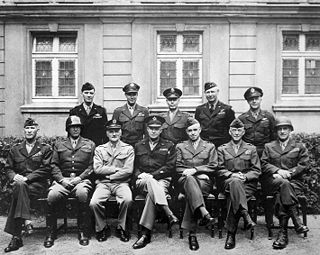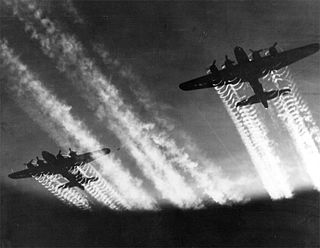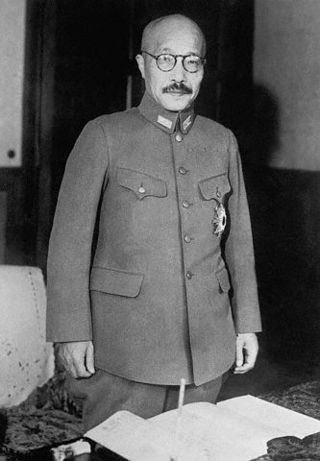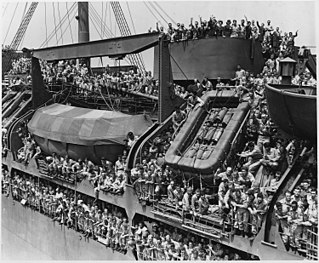Related Research Articles

The Tehran Conference was a strategy meeting of Joseph Stalin, Franklin D. Roosevelt, and Winston Churchill from 28 November to 1 December 1943. It was held at the Soviet Union's embassy at Tehran in Iran. It was the first of the World War II conferences of the "Big Three" Allied leaders and closely followed the Cairo Conference, which had taken place on 22–26 November 1943, and preceded the 1945 Yalta and Potsdam conferences. Although the three leaders arrived with differing objectives, the main outcome of the Tehran Conference was the Western Allies' commitment to open a second front against Nazi Germany. The conference also addressed the 'Big Three' Allies' relations with Turkey and Iran, operations in Yugoslavia and against Japan, and the envisaged postwar settlement. A separate contract signed at the conference pledged the Big Three to recognize Iranian independence.

The European Theater of Operations, United States Army (ETOUSA) was a theater of Operations responsible for directing United States Army operations throughout the European theatre of World War II, from 1942 to 1945. It commanded Army Ground Forces (AGF), United States Army Air Forces (USAAF), and Army Service Forces (ASF) operations north of Italy and the Mediterranean coast. It was bordered to the south by the North African Theater of Operations, United States Army (NATOUSA), which later became the Mediterranean Theater of Operations, United States Army (MTOUSA).

The Cairo Conference also known as the First Cairo Conference, one of the 14 summit meetings during World War II, took place on November 22–26, 1943. The Conference was held at Cairo in Egypt between China, the United Kingdom and the United States. It outlined the Allied position against the Empire of Japan during World War II and made decisions about post-war Asia. The conference was attended by Chairman Chiang Kai-shek, British Prime Minister Winston Churchill and US President Franklin D. Roosevelt.
Operation Sledgehammer was an Allied plan for a cross-Channel invasion of Europe during World War II, as the first step in helping to reduce pressure on the Soviet Red Army by establishing a Second Front. It was to be executed in 1942 and acted as a contingency alternative to Operation Roundup, the original Allied plan for the invasion of Europe in 1943. Allied forces were to seize the French Atlantic ports of either Brest or Cherbourg and areas of the Cotentin Peninsula during the early autumn of 1942, and amass troops for a breakout in the spring of 1943.

The First Quebec Conference, codenamed Quadrant, was a highly secret military conference held during World War II by the governments of the United Kingdom, Canada, and the United States. It took place in Quebec City on August 17–24, 1943, at both the Citadelle and the Château Frontenac. The chief representatives were Winston Churchill and Franklin D. Roosevelt, hosted by the Canadian prime minister William Lyon Mackenzie King.

The Combined Chiefs of Staff (CCS) was the supreme military staff for the United States and Britain during World War II. It set all the major policy decisions for the two nations, subject to the approvals of British Prime Minister Winston Churchill and U.S. President Franklin D. Roosevelt.

The Casablanca Conference or Anfa Conference was held in Casablanca, French Morocco, from January 14 to 24, 1943, to plan the Allied European strategy for the next phase of World War II. The main discussions were between US President Franklin Roosevelt and British Prime Minister Winston Churchill. Stalin could not attend. Key decisions included a commitment to demand Axis powers' unconditional surrender; plans for an invasion of Sicily and Italy before the main invasion of France; an intensified strategic bombing campaign against Germany; and approval of a US Navy plan to advance on Japan through the central Pacific and the Philippines. The last item authorized the island-hopping campaign in the Pacific, which shortened the war. Of all the decisions made, the most important was the invasion of Sicily, which Churchill pushed for in part to divert American attention from opening a second front in France in 1943, a move that he feared would result in very high Allied casualties and not be possible until 1944.
The First Washington Conference, also known as the Arcadia Conference, was held in Washington, D.C., from December 22, 1941, to January 14, 1942. President Roosevelt of the United States and Prime Minister Churchill of the United Kingdom attended the conference, where they discussed a future United Nations.

The Allies, formally referred to as the United Nations from 1942, were an international military coalition formed during World War II (1939–1945) to oppose the Axis powers. Its principal members by the end of 1941 were the "Big Four" – the United Kingdom, United States, Soviet Union, and China.
Operation Roundup was the codename for a plan to invade Northern France in the spring of 1943 prepared by Allied forces during World War II.
Tiger Force, also known as the Very Long Range Bomber Force, was the name given to a World War II British Commonwealth long-range heavy bomber force, formed in 1945, from squadrons serving with RAF Bomber Command in Europe, for proposed use against targets in Japan. The unit was scheduled to be deployed to Okinawa in the Pacific theatre in the lead-up to the Allies' proposed invasion of Japan. The unit was disbanded after the bombings of Hiroshima and Nagasaki and the Soviet invasion of Manchuria ended the war.

The military history of the United States during World War II covers the nation's role as one of the major Allies in their victory over the Axis Powers. The United States is generally considered to have entered the conflict with the 7 December 1941 surprise attack on Pearl Harbor by the Empire of Japan and exited it with the 2 September 1945 surrender of Japan. During the first two years of World War II, the US maintained formal neutrality, which was officially announced in the Quarantine Speech delivered by US President Franklin D. Roosevelt in 1937. While officially neutral, the US supplied Britain, the Soviet Union, and China with war materiel through the Lend-Lease Act signed into law on 11 March 1941, and deployed the US military to replace the British forces stationed in Iceland. Following the 4 September 1941 Greer incident involving a German submarine, Roosevelt publicly confirmed a "shoot on sight" order on 11 September, effectively declaring naval war on Germany and Italy in the Battle of the Atlantic. In the Pacific Theater, there was unofficial early US combat activity such as the Flying Tigers.

The Second Cairo Conference of December 4–6, 1943, held in Cairo, Egypt, addressed Turkey's possible contribution to the Allies in World War II. The meeting was attended by President Franklin D. Roosevelt of the United States, Prime Minister Winston Churchill of the United Kingdom, and President İsmet İnönü of the Republic of Turkey.

The Third Washington Conference was held in Washington, D.C from May 12 to May 25, 1943. It was a World War II strategic meeting between the heads of government of the United Kingdom and the United States. It was the third conference of the 20th century, but the second conference that took place during the US involvement in the Second World War. The delegations were headed by Winston Churchill and Franklin D. Roosevelt, respectively.

Japan's attack on Pearl Harbor took place on December 7, 1941. The United States military suffered 19 ships damaged or sunk, and 2,403 people were killed. Its most significant consequence was the entrance of the United States into World War II. The US had previously been officially neutral but subsequently entered the Pacific War, and after Italy's declaration of war and Germany's declaration of war shortly after the attack, the Battle of the Atlantic and the European theatre of war. Following the attack, the US interned 120,000 Japanese Americans, 11,000 German Americans, and 3,000 Italian Americans.

This is a timeline of events that occurred during World War II in 1943.
The diplomatic history of World War II includes the major foreign policies and interactions inside the opposing coalitions, the Allies of World War II and the Axis powers, between 1939 and 1945.

The Demobilization of United States armed forces after the Second World War began with the defeat of Germany in May 1945 and continued through 1946. The United States had more than 12 million men and women in the armed forces at the end of World War II, of whom 7.6 million were stationed abroad. The American public demanded a rapid demobilization and soldiers protested the slowness of the process. Military personnel were returned to the United States in Operation Magic Carpet. By June 30, 1947, the number of active duty soldiers, sailors, Marines, and airmen in the armed forces had been reduced to 1,566,000.

The third presidential term of Franklin D. Roosevelt began on January 20, 1941, when he was once again inaugurated as the 32nd president of the United States, and the fourth term of his presidency ended with his death on April 12, 1945. Roosevelt won a third term by defeating Republican nominee Wendell Willkie in the 1940 United States presidential election. He remains the only president to serve for more than two terms. Unlike his first two terms, Roosevelt's third and fourth terms were dominated by foreign policy concerns, as the United States became involved in World War II in December 1941.
The foreign policy of the United States was controlled personally by Franklin D. Roosevelt during his first and second and third and fourth terms as the president of the United States from 1933 to 1945. He depended heavily on Henry Morgenthau Jr., Sumner Welles, and Harry Hopkins. Meanwhile, Secretary of State Cordell Hull handled routine matters. Roosevelt was an internationalist, while powerful members of Congress favored more isolationist solutions in order to keep the U.S. out of European wars. There was considerable tension before the Attack on Pearl Harbor in December 1941. The attack converted the isolationists or made them irrelevant. The US began aid to the Soviet Union after Germany invaded it in June 1941. After the US declared war in December 1941, key decisions were made at the highest level by Roosevelt, Britain's Winston Churchill and the Soviet Union's Joseph Stalin, along with their top aides. After 1938 Washington's policy was to help China in its war against Japan, including cutting off money and oil to Japan. While isolationism was powerful regarding Europe, American public and elite opinion strongly opposed Japan.
References
- Hornfischer, James D. Neptune's Inferno: The US Navy at Guadalcanal. New York: Bantam Books, 2011. ISBN 978-0-553-80670-0.